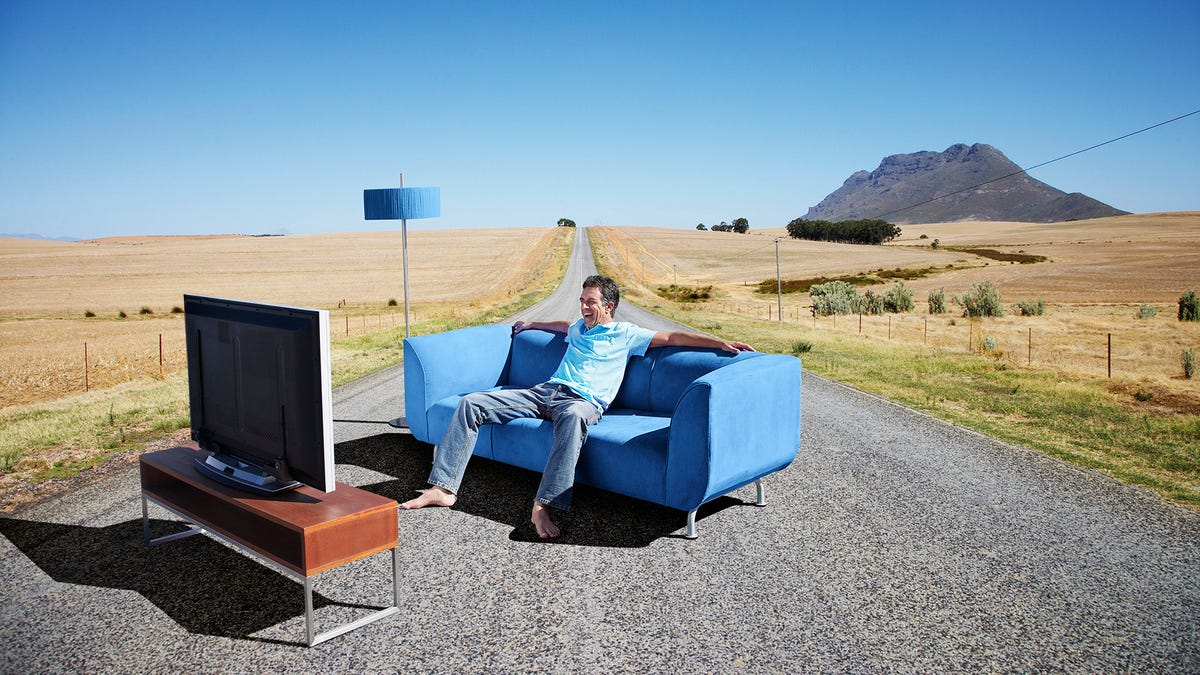 Why You Can Trust CNET
Why You Can Trust CNET Why You Shouldn't Take Your Indoor TV Outside for the Summer
Taking your TV onto the deck may seem like an easy alternative to costly outdoor TVs, but here's why it's not so simple.

Summer is here, and with the sunny days and warm weather, you're probably eager to spend as much time as possible outside. If you have a nice outdoor space like a deck or gazebo, covered or not, you might be curious if you can enjoy TV outside too. After all, watching the big game with friends, movie nights with the family, even just sitting by the pool and binge-watching a new show all seem better enjoyed on a big screen rather than your phone or tablet.
Dedicated outdoor TVs are expensive, however. The brand-new Element outdoor Roku TV is one of the cheapest we've seen and it still costs $1,300, mainly because it's designed to be relatively weatherproof. So why not save hundreds of dollars and bring a standard TV outside? A simple wall mount, perhaps an extension cord to a nearby exterior outlet, and you're good to go, right?
Not so fast. Much like putting a TV in the bathroom, even if it seems your display is away from direct splashes of water, it's in peril. Mounting a regular TV outside is the fastest way to destroy it, other than enthusiastic defenestration. Here's why.
No Groot, we can't watch Tree of Life again.
The fragility of televisions
Heat, humidity and direct sunlight are the enemies of all TVs. For example, here's what LG lists as the operating temperatures for one of its LCD TVs:
- Operating temperature 0 to 40 degrees C (32 to 104 degrees F)
- Operating humidity less than 80%
Most parts of the US fall outside that range at least a few times a year. LG also advises to "keep the product away from direct sunlight" and not to place the TV in an "area exposed to rain or wind." Other manufacturers have similar temperature and humidity ranges for their televisions.
Anyone know where I can get more salt for this margarita? Wait, never mind.
You might be thinking, "I have the perfect spot that's covered and out of the sun." Can you install a regular TV in a seemingly "safe" environment? You could. No one will stop you. I'm sure it will even work the first few times you try. Just know that TVs are intricate, fragile devices. Used normally they can last many years. Used outside of their prescribed environment, like adding heat, moisture and sunlight, the TV will age significantly faster. If you can afford to replace a TV every few months or every year, you do you. I'm sure TV manufacturers will be extremely pleased. Just don't expect any warranty coverage.
Dedicated outdoor TVs are expensive
Several companies make TVs designed for the elements. This is more difficult than it sounds. Sealing a TV against moisture, plus any curious wildlife, limits the TV's ability to cool itself. Heat, as we've discussed before, is by far the biggest enemy of TV longevity. So this rugged redesign, plus the additional components and weather sealing, increase the price.
That Element Roku TV is a 55-inch model with IP55 dust and water resistance but at $1,300 it costs four times as much as a regular Roku TV -- and other outdoor TVs cost even more. Samsung's The Terrace is IP55 and costs $3,500 for a 55-inch model. Another big name in the space, SunBrite, specializes in outdoor TVs and its similarly sized TVs cost around $3,000.
The Nature channel in 8K looks so lifelike!
Which is to say, doing the job "right" not only isn't cheap, but likely beyond the means of anyone looking to just watch some Netflix on the patio. Fortunately, there are some other options.
What, Mom? You told us to go outside. We're outside.
'TV' under the stars
Another option, though still not "cheap," is a TV enclosure. These help protect your TV from the elements, including the front screen, vents on the back, and so on. Some models even have optional antiglare screens, highly important as even a bright TV is going to have trouble competing with the sun. They can also have heaters or fans, to help keep the TV in its comfort zone. However, these enclosures often cost as much as the TV itself. They'll also extend your poor TV's life, but not indefinitely. It's not an outdoor TV now. It's an indoor TV wearing a nice coat.
If you're just planning on watching at night, consider a projector instead. These are likely cheaper than a TV plus enclosure, and are small enough to easily bring back inside when you're done for the night. They can project onto the side of your house, or better yet, a collapsible screen. Even a big sheet works quite well. Battery powered models aren't particularly bright, but just need Wi-Fi to stream. For larger, brighter models, you'll need to run a power cable. These can create images 100 inches or larger with ease, however, making backyard movie night something truly special.
If none of these work for you, consider getting a wheeled cart so the TV is only outside when you're actually watching it. That's definitely not as cool, or as easy, as mounting a TV outside, but it will save you money in replacement costs in the long run.
As well as covering TV and other display tech, Geoff does photo tours of cool museums and locations around the world, including nuclear submarines, massive aircraft carriers, medieval castles, epic 10,000 mile road trips, and more. Check out Tech Treks for all his tours and adventures.
He wrote a bestselling sci-fi novel about city-size submarines, along with a sequel. You can follow his adventures on Instagram and his YouTube channel.

